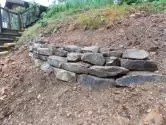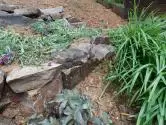Another Airport, Another Project

Last week found me traveling to Fort Lauderdale, city of a thousand strip malls, and once again my trip ended with me sitting in an airport planning my next house project.
If you read last week’s column, you know that my previous trip had given me time to plan Project Quail, which led to the release of 24 bobwhite quail in a back corner of one of our former horse pastures. The quail stayed around the brush pile I had created for them for about two days, but have since ventured deeper into the woods in search of bugs and grubs. I continue to put cracked corn out for them each evening, and while I haven’t seen any of them for about a week, I can listen to them calling to each other from beneath the safety of the thorny brambles.
This week’s project was a return to one of my favorites: a dry stacked rock wall.
Dry stacked, as its name implies, means no wet mortar. These are best used in minor landscaping projects, such as preventing erosion on a hillside and providing terraces for plantings. In my case we needed a series of low rock walls to enable us to dig out the unwanted grasses on a hillside, and then replace them with perennial plantings without the freshly turned dirt washing away. Dry stacking is made much easier if your rocks are (1.) relatively flat, and (2.) can lean back for support against a hillside or concrete block wall.
Natural stone walls are as much a part of the Arts and Crafts vernacular as are pegged joints and matte green glazes. Gustav Stickley devoted several pages to rock walls in The Craftsman magazine, and architects such as Charles and Henry Greene often incorporated them into their residential exteriors and landscape plans.
Perhaps the ultimate Arts and Crafts rock structure is the 1913 Grove Park Inn, originally a six-story, 150-room hotel constructed of granite boulders hauled down from the adjacent mountains ringing Asheville. In a letter written the year prior to construction, one architect made this astute recommendation to owner E. W. Grove: carefully calculate how many rocks you will need — then double it.
Since you may well find yourself traveling out to a ‘rock yard,’ let me tell you of my first experience years ago going to pick out rocks for a low retaining wall in our yard. On my way back from the post office, I casually drove my Dodge Caravan into the large, dusty lot that was my nearest rock yard down by the French Broad River. It was hot, so I had on shorts and sandals. I could see two men sitting in the wood shanty marking the entrance to the rock yard, but neither made any attempt to pry themselves out of their chairs to come see what I wanted. After twenty minutes of wandering around pallets stacked with a dozen different varieties of rocks, I climbed back into my car and drove home.
I returned the following day, but this time rather than driving our family car and looking like I was headed to the beach, I drove my old Ford pickup truck and brought along Jake, our yellow lab. I had traded my sandals and shorts for a pair of Wolverine work boots, a worn Carolina t-shirt, a Braves baseball cap, and a pair of Wrangler jeans with my leather gloves hanging limply out of the rear pocket.
The same two guys were in the wood shanty, but this time they were falling over each other in their rush to come help me and Jake pick out our rocks.
Dress for success, right?

Until next week,
Thanks for stopping by!
Bruce
